355 Search Results for assessment
March 29, 2013
by Carole Zangari -
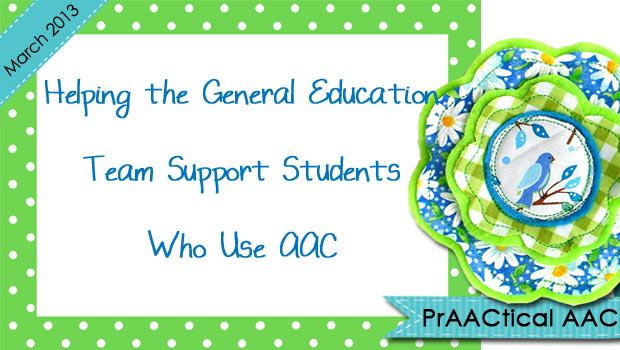
In the past few months, we’ve shared some articles on AAC in general education. We’ve looked at the development of an AAC intervention plan that relates to curriculum standards and using math and science standards as a context for building AAC skills. In this post, I’d like to share my own contribution to that issue of ASHA’s Special Interest Group (SIG) quarterly publication, Perspectives on AAC. Although the final versions are available only to SIG members, clearance has been given to post the original articles. As we all know, AAC skills are best learned when the entire team is headed in the same direction, using robust instructional methods, and communicating well with one another. In this article, I discuss some of the ways that we can clarify the expectations of each team member so that all the bases are covered and our individual efforts complement one another. Thoughts on managing assessment... [Read More...]
March 23, 2013
by Robin Parker -
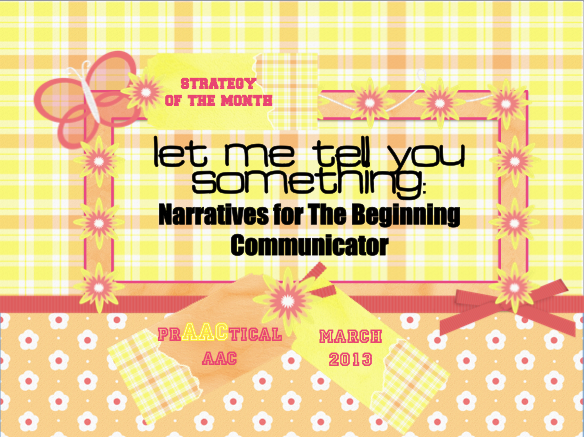
March continues with story telling or narratives as the Strategy of the Month. All learners have stories to tell but some may need special teaching to be able to express their stories. Goals for the beginning communicator can and should include narratives. Personal narratives are a good place to begin but any type of narrative can be taught with structure, routines, partner support, prAACtical strategies. Robust communication includes story telling. Yes, beginning communicators need to be able to express wants and needs however, authentic and comprehensive language involves much more. The quicker we start teaching, the quicker beginning communicators (or anyone) can learn. Beginning Communicator Narratives 3 Types (Just some of the options) Remnant Books are a visual and tactile way of telling stories by recording important events. Learners can help choose items from meaningful personal experiences which serve as a reminder of stories to tell. Create routines and visual supports... [Read More...]
March 9, 2013
by Robin Parker -
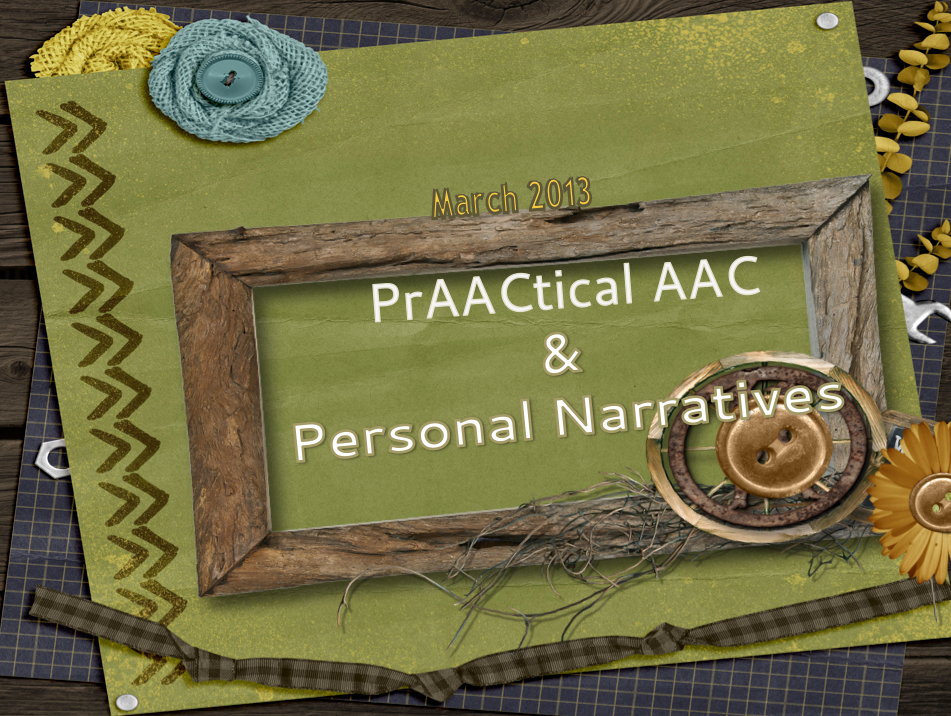
Personal narratives are the first story skills that develop. They tell about ourselves and our connection to activities, places, and events. They tell about how we feel about people and experiences. Personal narratives help us structure and organize the events of our lives and even become a way of thinking about ourselves and our identities. We know many AAC users have significant difficulty with narratives. We always wonder though, is it a function of language difficulty or of access, exposure, and PrAACtice or more likely a combination. There are key intervention strategies that help AAC learners be able to tell personal narratives. You probably won’t be surprised by what strategies work but the research from Gloria Soto and colleagues has shown us that when applied to personal narratives, AAC users can be competent story tellers. Some Thoughts on Personal Narrative Assessment Even before assessment of the AAC learner, in all fairness,... [Read More...]
March 2, 2013
by Carole Zangari -
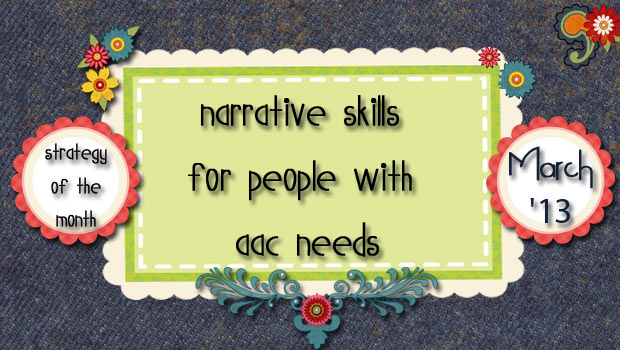
This month, we’ll share some thoughts about helping people with AAC needs develop narrative skills. Why narrative skills? Because they help us connect to one another and communication learning works best when we feel connected. Among other things, storytelling helps us relate to one another. Narrative language is important for reading and writing skills to develop. It helps us understand the world and ourselves. In telling our stories, we establish our identities. Plus, it’s part of what makes life fun. In the US, pediatric therapists are having lots of conversations about the Common Core State Standards (CCSS) in English Language Arts (ELA), and how they relate to the IEP goals of the students that they serve. Many of the goals in the ELA speaking domain require students to be able to summarize what they hear and read, so it is no surprise that SLPs are prioritizing narrative language and related... [Read More...]
February 21, 2013
by Carole Zangari -

We couldn’t be happier to have a guest post by Jane Farrall for our How I Do It series. Jane has worked as a school and adult service based speech pathologist and literacy teacher. She has also worked as an assistive technology specialist and is currently working as an independent consultant in literacy, AAC and Assistive Technology. Jane has been working in the disability and assistive technology field for over 20 years. She has extensive practical experience in both AAC and in teaching children and adults with disabilities to acquire literacy. She has completed a Masters in Special Education focusing on literacy acquisition in children and adults without speech. Jane is a former Chairperson of AGOSCI (Australian Group on Severe Communication Impairment) and is the founder and organiser of the Big Mouth Camp, a camp for school aged students using speech generating devices and their families. You can get more... [Read More...]
January 25, 2013
by Carole Zangari -

Many of our prAACtical AAC friends are members of ASHA’s Special Interest Group (SIG) on AAC and are able to access their quarterly publication, Perspectives on AAC. I was fortunate to be invited to submit an article for the September 2012 edition, guest edited by Gail Van Tatenhove, on the topic of including students with robust AAC devices in general education classrooms. Access to the final publication is limited to those who are ASHA SIG members, but Gail did get clearance for authors to be able to share their original unedited works. Several of those authors have given permission for their articles to be published on the Minspeak website and also here on our site. In this post, we would like to share the work of Solana Henneberry, Jennifer Kelso, and Gloria Soto. This article describes a process of developing an AAC intervention plan that relate to the Common Core... [Read More...]
January 22, 2013
by Robin Parker -
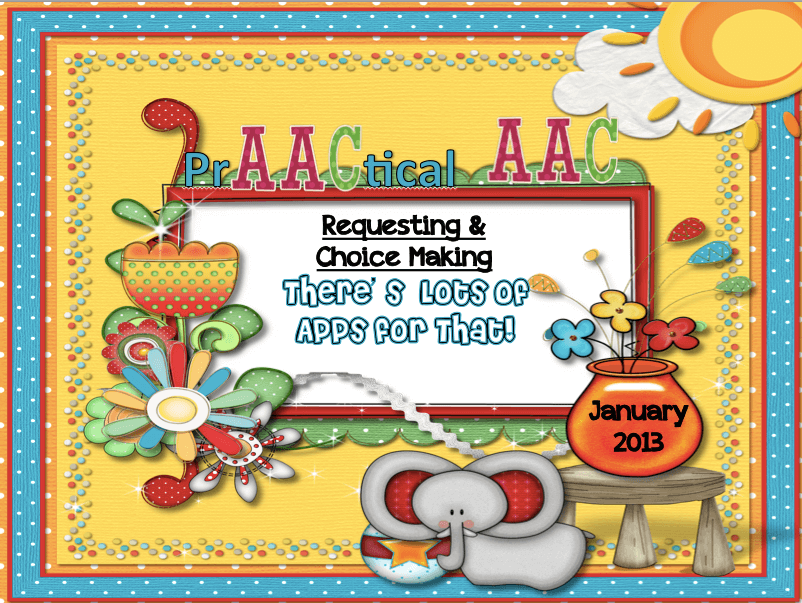
As the saying goes, there is an app for ‘that’. There are now a lot of apps, and a lot of apps for choice making and requesting. Here are a few just a few of the many, many options: Preference Assessment App Preference & Reinforcer Assessment- Autism & Special Education Requesting & Choice Making Choice Board Creator My Choice Board Look 2 Learn AAC Apps (fully customizable and can easily make folders of choice boards, but also do a lot more) Go Talk Now Free & Go Talk Now PictureCanTalk So Much 2 Say- Picture Communication *All of the AAC apps can inherently be used for requesting and choice making. Check out Jane Farrall’s AAC Apps for a comprehensive list and our post listing 119 free and light versions of AAC apps and for more options check out the AAC Appy Store. Apps for Creating No Tech Communication and Choice Boards Custom Boards Picture Card... [Read More...]
January 21, 2013
by Carole Zangari -
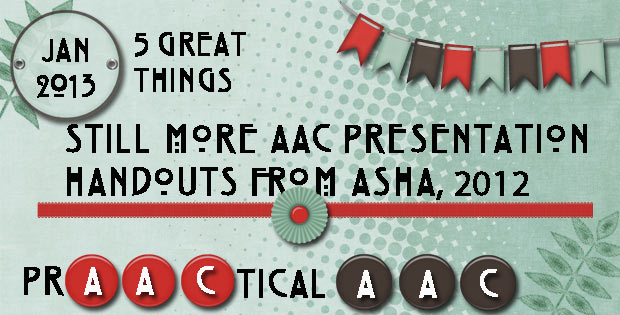
Hope that many of our prAACtical friends are working on proposals for the 2013 ASHA Convention in Chicago. To inspire us all, here are five presentation handouts from previous annual conference. AAC: What Was, Is, & Hopefully Will Be by David Yoder Effectiveness of Telerehabilitation in AAC Service Delivery by Tanya Curtis Creating a Framework for AAC Evidence-Based Assessment by Elizabeth (Libby) Rush and Celeste Helling Determining Effectiveness of a Communication Program for Children With Autism by Meher Banajee, Timothy Morse, Angie Pardee and Morgan Weihing AAC & Autism: Collaboration, Training, & Data Collection in School by Amy Golding and Deidre King Good luck with those proposals!
January 19, 2013
by Robin Parker -
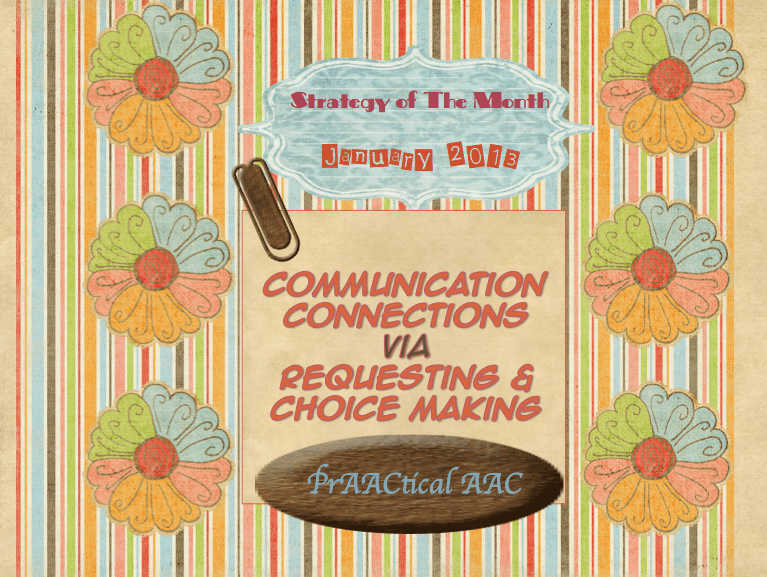
The January Strategy of the Month has focused on requesting and choice making. These are really fun goals to implement. They fall under the communication function that helps us meet our own needs (Behavioral Regulation). When we get what we want, there is a sense of control over the environment & we increase symbolic communication/language, and self-sufficiency. It’s all good. The assumption for all requests and choices is that the learner ‘likes’ what they have asked for. This is what makes the process so much fun, we get to do activities and have interactions that are positive and motivating. If only it was that easy… Sometimes it is not… But do not worry…there are plenty of solutions for common (and not so common) problems when teaching requesting and choice making. As always, set the stage for a positive TEACHING paradigm and then move to problem solving if necessary (and when it is... [Read More...]
January 10, 2013
by Carole Zangari -
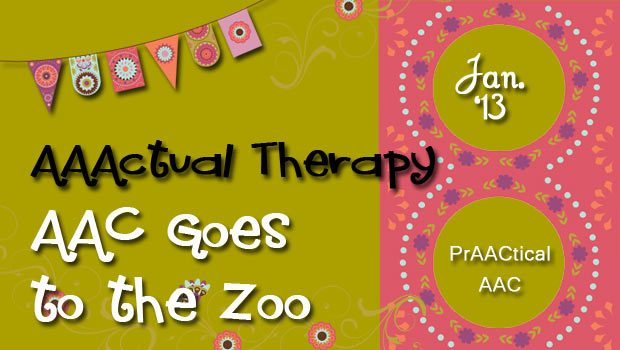
Welcome to AACtual Therapy, a new series on PrAACtical AAC that we’re undertaking in order to give you an up-close-and-personal look at SLPs who ‘do’ AAC. Each of these posts will feature one of our prAACtical friends, some of whom have been AAC interventionists for awhile and others who have come to it more recently. Each one is passionate about giving people a voice no matter what their age or ability level. They’ll be giving us a peek into an AAC therapy lesson that they use, and telling us about the strategies that make it successful. They’ll share a bit about the goals and objectives the lesson was designed to address, and what sorts of AAC their clients are using. Hopefully, we’ll see them in action Here’s what NOT to expect: Perfection. It doesn’t exist, so we don’t even bother looking for it. We’re featuring these clinicians because we want... [Read More...]









